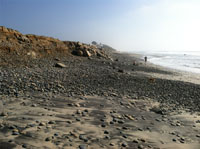6.4: Lithogenous Sediments
- Page ID
- 9976
Lithogenous Sediments
Lithogenous sediments form through the processes of weathering and erosion of materials exposed on land and along coastlines. Lithogenous sediments consist of solid fragments of inorganic or organic material that come from the weathering of rock and soil erosion, and are carried and deposited by wind, water, or ice. Lithogenous sediments are also commonly called "terrigenous sediments" because they are derived dominantly from terrigenous (land) sources. They are also called "clastic sediments" because they are made up of rock fragments derived from other rocks—a "clast" is a Greek word for a rock fragment.

Lithogenous sediments are:
• Mostly small pieces of broken rock transported to ocean from the land (wind, rivers, glaciers, coastal erosion, turbidity currents etc.)
• Generally form deposits rapidly (such as sand on a beach or a river delta)
• Can form in high energy environments and have coarse grain sizes (coarse sand, gravel, cobbles, and boulders).
• Beach sand is mostly composed of the quartz (SiO2), a mineral which very resistant to weathering.
• Most lithogenous sediments eventually are deposited along the margins of ocean basins.
• Some is deposited into the deep ocean by currents and underwater landslides near continents, and far offshore, lithogenous sediment of fine silt and clays, some as desert dust, forest-fire ash, or volcanic ash blown in by the wind.


